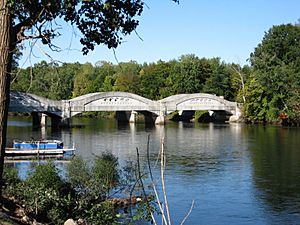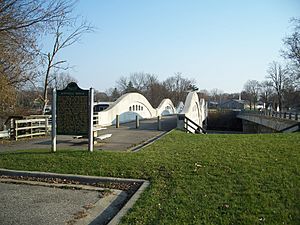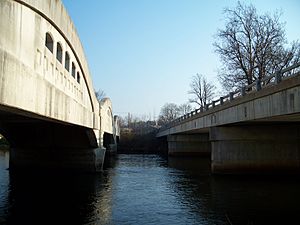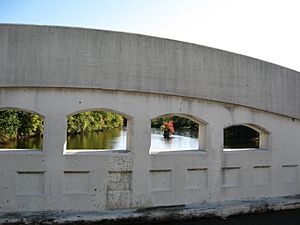US 12–St. Joseph River Bridge facts for kids
Quick facts for kids US 12–St. Joseph River Bridge |
|
|---|---|

The bridge's three spans
|
|
| Coordinates | 41°48′00″N 85°45′25″W / 41.8000°N 85.7569°W |
| Carries | Pedestrians |
| Crosses | St. Joseph River |
| Locale | Mottville, Michigan |
| Other name(s) | Mottville Bridge |
| Characteristics | |
| Total length | 270 ft (82 m) |
| Number of spans | 3 |
|
US 12–St. Joseph River Bridge
|
|
| Built | 1922 |
| NRHP reference No. | 91000388 |
| Significant dates | |
| Added to NRHP | April 5, 1991 |
The US 12–St. Joseph River Bridge is a special kind of bridge called a camelback bridge. It has three sections, or spans. You can find it in Mottville, Michigan. This bridge used to carry a major road, U.S. Route 12, over the St. Joseph River.
It was built in 1922 and is actually the fourth bridge to stand in this exact spot. Since 1990, it has been used only by people walking or biking. A new bridge was built next to it for cars. This bridge is the longest camelback bridge still standing in Michigan. It is recognized as a Michigan State Historic Site and is also listed on the National Register of Historic Places.
Contents
Bridge History: How It Came to Be
The US 12–St. Joseph River Bridge is the fourth bridge to cross the St. Joseph River in this area. Long ago, the Great Sauk Trail crossed the river at a shallow spot nearby. In 1825, this trail became the Chicago Road, which is now US 12.
Early Bridges at This Spot
The very first bridge here was made of timber and built between 1833 and 1834. Then, in 1845, a new bridge supported by piles (long posts driven into the ground) was built. After that, in 1867, a covered bridge with a special Burr arch truss design was constructed. You can still see parts of its old supports, called abutments. This covered bridge was very long, about 285 feet (87 meters), and 25 feet (7.6 meters) wide. It was later sold to a farmer who used its wood to build a barn in 1927.
Building the Camelback Bridge
The current camelback bridge was built in 1922. The company that built it was Smith and Nichols from Hastings, Michigan.
Protecting a Piece of History
On April 10, 1986, the bridge was named a Michigan State Historic Site. A special sign was put up on October 31, 1989, to tell people about its history. In 1990, a new bridge opened next to it for cars. The old bridge was then used only for people walking. The Michigan Department of Transportation decided to keep the old bridge. They wanted to save it as an important example of engineering. On April 5, 1991, the bridge was added to the National Register of Historic Places. This means it is a very important historical place in the country.
Bridge Design: What Makes It Special
This bridge was built using standard plans from the Michigan State Highway Department. These plans were common in the early 1920s. The bridge is located at the western edge of Mottville.
Longest of Its Kind
At 270 feet (82 meters) long, it is the longest camelback bridge still standing in Michigan. It has three parts, or spans, that are all the same size. Each span is about 90 feet (27 meters) long.
Strong and Decorative
The bridge is made of strong, reinforced concrete. It stands on concrete piers (supports in the water) and abutments (supports on the land). Inside, it has reinforced steel girders that form its arches. Each arch has five openings and special decorative areas. These features make the bridge both strong and nice to look at.






